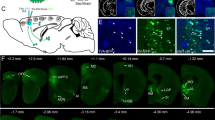Summary
Pinealocytes of rhesus monkeys that had been ovariectomized and given intramuscular injections of 250 μg estradiol-benzoate for 3 consecutive days tended to have more synaptic ribbons (SR) and exhibited a significantly greater size of ribbon fields (RF) compared to untreated animals. These data are consistent with hypotheses that pinealocyte function in primates is altered by hormonal imbalances and that the SR participates in this response. RF were positioned in various parts of the cytoplasm and along the plasma membrane. Participation of SR in direct cell-to-cell contacts was suggested by the formation of densities along the plasma membrane. It is postulated that large RF serve as storage organelles and that the formation of RF results from division of pre-existing SR in each field. Reconstructions made from serial thin sections revealed that profiles of RF comprised separate SR that were not folded and sectioned along various planes.
Similar content being viewed by others
References
Brownstein M, Axelrod J (1974) Pineal gland: 24-hour rhythmcx in norepinephrine turnover. Science 184:163–165
Cardinali DP (1981) Hormone effects on the pineal gland. In: Reiter RJ (ed) The pineal gland Vol 1 Anatomy and biochemistry. CRC Press, Boca Raton, pp 243–272
Cardinali DP, Nagle CA, Gomez E, Rosner JM (1975) Norepinephrine turnover in the rat pineal gland, acceleration by estradiol and testosterone. Life Sci 16:1717–1724
Cardinali DP, Gomez E, Rosner JM (1976) Changes in [3H] leucine incorporation into pineal proteins following estradiol or testosterone administration: involvement of the sympathetic superior cervical ganglion. Endocrinology 98:849–858
Hewing M (1980) Cerbrospinal fluid-contacting area in the pineal recess of the vole (Microtus agrestis), guinea pig (Cavia cobaya), and rhesus monkey (Macaca mulatta). Cell Tissue Res 209:473–484
Hewing M (1981) Topographical relationships of synaptic ribbons in the pineal system of the vole (Microtus agrestis) Anat Embryol 162:313–323
Karasek M (1976) Quantitative changes in number of “synaptic” ribbons in rat pinealocytes after orchidectomy and in organ culture. J Neural Trans 38:149–157
Karasek M (1981) Some functional aspects of the ultrastructure of rat pinealocytes. Endocrinol Exp 15:17–34
Karasek M, Marek K (1980) Influence of estradiol on the ultrastructure of the rat pineal gland. Acta Med Pol 21:335–336
Karasek M, King TS, Hansen JT, Reiter RJ (1982a) Quantitative changes in the number of dense-core vesicles and “synaptic” ribbons in pinealocytes of the Djungarian hamster (Phodopus sungorus) following sympathectomy. Cytobios 35:157–162
Karasek M, King TS, Richardson BA, Hurlbut EC, Hansen JT, Reiter RJ (1982b) Day-night differences in the number of pineal “synaptic” ribbons in two diurnal rodents, the chipmunk (Tamias striatus) and the ground squirrel (Spermophilus richardsonii). Cell Tissue Res 224:689–692
Karasek M, King TS, Hansen JT, Reiter RJ (1982c) Ultrastructure of the pineal gland of the Eastern chipmunk (Tamias striatus). J Morphol 173:73–86
King TS, Dougherty WJ (1980) Neonatal development of circadian rhythm in “synaptic” ribbon numbers in the rat pinealocyte. Am J Anat 157:335–343
King TS, Dougherty WJ (1982a) Effect of denervation on “synaptic” ribbon populations in the rat pineal gland. J Neurocytol 11:19–28
King TS, Dougherty WJ (1982b) Age-related changes in pineal “synaptic” ribbon populations in rats exposed to continuous light and darkness. Am J Anat 163:169–179
Kosaras B, Welker HA, Vollrath L (1983) Pineal “synaptic” ribbons and spherules during the estrous cycle in rats. Anat Embryol 166:219–227
McNulty JA (1980) Ultrastructural observations on synaptic ribbons in the pineal organ of the goldfish. Cell Tissue Res 210:249–256
Pévet P (1983) Anatomy of the pineal gland in mammals. In: Relkin R (ed) The pineal gland, Elsevier Biomedical, New York, pp 1–75
Pévet P, Yadav M (1980) The pineal gland of equatorial mammals. I. The pinealocytes of the Malaysian rat (Rattus sabanus). Cell Tissue Res 210:417–433
Romero JA, Axelrod J (1974) Pineal β-adrenergic receptor: diurnal variation in sensitivity. Science 184:1091–1092
Romijn HJ (1975) The ultrastructure of the rabbit pineal gland after sympathectomy, parasympathectomy, continuous illumination, and continuous darkness. J Neural Transm 36:183–194
Ruiz-Navarro A, Blanco-Rodriguez A, Gasquez-Ortiz A, Jover-Moyano A (1982) Synaptic ribbons in pinealocytes of castrated rats and rats treated with estradiol. Cell Biol Int Reports 6:629–633
Theron JJ, Biagio R, Meyer AC, Boekkooi S (1979) Microfilaments, the smooth endoplasmic reticulum and synaptic ribbon field in the pinealocytes of the baboon (Papio ursinus). Am J Anat 154:151–162
Theron JJ, Biagio R, Meyer AC (1981) Circadian changes in microtubules, synaptic ribbons and synaptic ribbon fields in the pinealocytes of the baboon (Papio ursinus). Cell Tissue Res 217:405–413
Vollrath L (1973) Synaptic ribbons in the mammalian pineal gland. Circadian changes. Z Zellforsch 145:171–183
Vollrath L (1981) The pineal organ. Handb mikrosk Anat Mensch VI/7. Springer-Verlag, Berlin, pp 589
Vollrath L, Howe C (1976) Light and drug induced changes in epiphysial synaptic ribbons. Cell Tissue Res 165:383–390
Vollrath L, Huss H (1973) The synaptic ribbons of the guinea pig pineal gland under normal and experimental conditions. Z Zellforsch 139:417–429
Wartenberg H (1968) The mammalian pineal organ: electron microscopic studies on the fine structure of pinealocytes, glial cells and on the perivascular compartment. Z Zellforsch 86:74–97
Welsh MG, Hansen JT, Reiter RJ (1979) The pineal gland of the gerbil, Meriones unguiculatus III. Morphometric analysis and fluorescence histochemistry in the intact and sympathectically denervated pineal gland. Cell Tissue Res 204:111–125
Author information
Authors and Affiliations
Rights and permissions
About this article
Cite this article
McNulty, J.A., Fox, L., Taylor, D. et al. Synaptic ribbon populations in the pineal gland of the rhesus monkey (Macaca mulatta). Cell Tissue Res. 243, 353–357 (1986). https://doi.org/10.1007/BF00251051
Accepted:
Issue Date:
DOI: https://doi.org/10.1007/BF00251051




